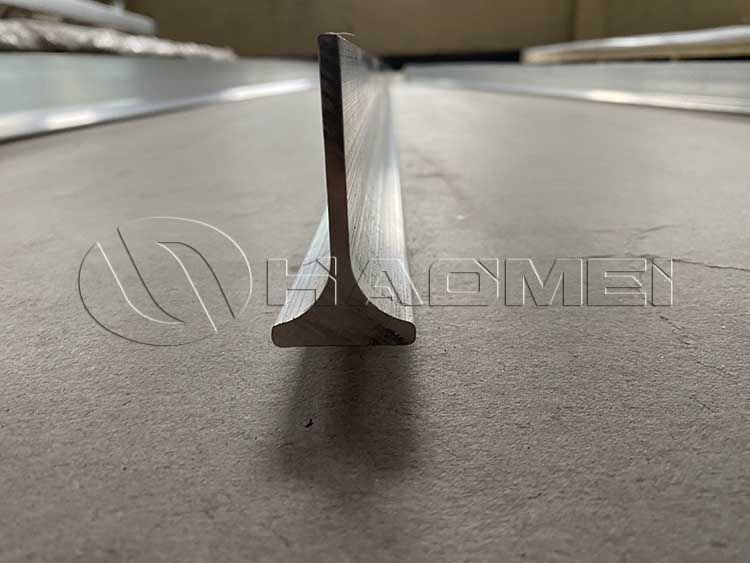The Use of T Shaped Aluminum Extrusion in Shipbuilding
Aluminum t shaped aluminum extrusion is typically made from specific aluminum alloys, with common alloying elements such as magnesium (Mg), silicon (Si), and copper (Cu). For example, 5083 alloy belongs to the Al-Mg alloy family. The addition of magnesium significantly improves the alloy's strength and corrosion resistance. In marine environments, seawater contains a high concentration of salt and is highly corrosive. 5083 alloy, with its excellent corrosion resistance, effectively resists seawater erosion, ensuring the long-term stability of ship structures.
 Another example is 6063 alloy, a medium-strength, heat-treatable alloy whose primary alloying elements are silicon and magnesium. 6063-T5 aluminum profiles offer excellent processability, corrosion resistance, wear resistance, and high mechanical strength. The T5 state refers to artificial aging after cooling from the forming temperature. This treatment further optimizes the profile's performance, ensuring it meets process requirements throughout the shipbuilding process.
Another example is 6063 alloy, a medium-strength, heat-treatable alloy whose primary alloying elements are silicon and magnesium. 6063-T5 aluminum profiles offer excellent processability, corrosion resistance, wear resistance, and high mechanical strength. The T5 state refers to artificial aging after cooling from the forming temperature. This treatment further optimizes the profile's performance, ensuring it meets process requirements throughout the shipbuilding process.
The Diverse Applications of Aluminum T-Profiles in Ships
Hull Structure: Aluminum T-profiles are widely used in the hull's skeleton structure. In small vessels such as speedboats and high-speed craft, weight reduction is crucial to achieving high speed. Aluminum T-profiles have a low density, only about one-third that of iron. Using aluminum T-profiles in the hull skeleton significantly reduces the weight of the vessel itself, significantly increasing speed under the same propulsion conditions.
Furthermore, in large vessels such as LNG cargo ships, aluminum T-profiles are used in parts of the hull structure, not only reducing weight but also meeting the stringent material requirements of LNG tanks due to their excellent performance in low-temperature conditions.
In the cabin interior: Within the cabin, aluminum T-profiles are used to create cabin partitions, decorative frames, and other components. Their excellent processability allows them to be formed into a variety of complex shapes to meet diverse cabin design requirements. Furthermore, the smooth surface and high-quality texture of aluminum T-profiles enhance the overall aesthetics and comfort of the cabin interior.
Deck Facilities: On ship decks, aluminum T-profiles can be used to manufacture railings, handrails, and support structures for equipment. For example, on the decks of some passenger ships and yachts, aluminum T-profile railings ensure passenger safety while also reducing maintenance due to their lightweight and corrosion-resistant properties. Their simple and elegant appearance blends seamlessly with the overall design of the vessel.
Significant Advantages of Aluminum T-Profiles
Lightweight: The low density of the aluminum t slot bar gives them an inherent advantage in marine applications. As mentioned above, lighter hulls can reduce engine capacity, lower fuel consumption, and increase ship speed. Furthermore, reduced weight improves the ship's aspect ratio, increasing stability and making it easier to maneuver during navigation. Compared to traditional steel ships, all-aluminum ships can reduce overall cabin weight by approximately 50%. This offers the dual benefits of increased transportation efficiency and reduced energy costs, aligning closely with the global "dual carbon" strategy.
Strong corrosion resistance: Ships are exposed to seawater for extended periods, placing extremely high demands on material corrosion resistance. Upon contact with air, aluminum T-profiles quickly form a dense, durable aluminum oxide film on their surface. This film acts as a natural protective shield, effectively shielding against the corrosive effects of various elements in seawater.
Combined with surface treatments such as anodizing, aluminum T-profiles remain remarkably stable in seawater, significantly extending the service life of the ship. In contrast, steel is susceptible to rust and corrosion in seawater, requiring frequent maintenance. Aluminum T-profiles significantly reduce this maintenance effort, lowering ship operating costs.
Excellent machining and welding properties: During shipbuilding, materials undergo a variety of machining processes. Aluminum T-profiles offer excellent cold and hot forming properties, enabling smooth processing through folding, hemming, roll bending, stamping, hot bending, and pyrotechnic straightening. They are also less prone to cracking and other defects during processing, while still meeting performance requirements for strength and corrosion resistance after processing.
Aluminum T-profiles also offer excellent welding properties, including good crack resistance and minimal performance differences in welded joints. This greatly facilitates shipbuilding welding and ensures secure and reliable connections within ship structures.
High recycling value and environmental sustainability: Aluminum scrap has a high recycling value and can be recycled. After a ship is decommissioned, components made from aluminum T-profiles can be recycled and reused. This not only helps conserve resources and reduces the need for new aluminum ore mining, but also reduces energy consumption and environmental pollution. This environmental sustainability aligns with modern society's pursuit of green development and provides strong support for the sustainable development of the shipbuilding industry.









